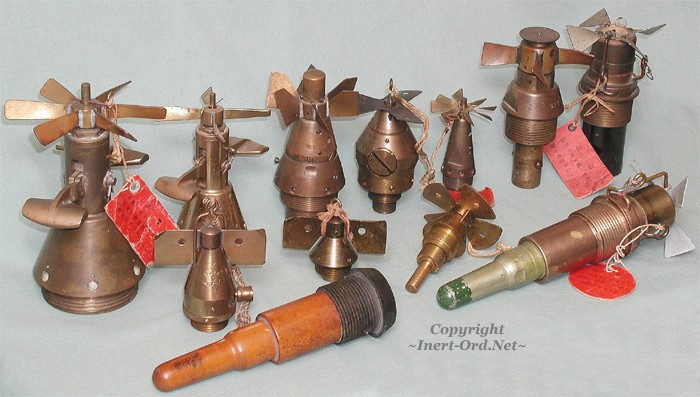Bomb fuzes are yet another interesting sub-set of militaria collecting. There are hundreds of designs but Japanese aerial bomb fuzes have a style and character that sets them apart from fuzes of other nations.... almost art forms. For the mechanically minded, there are lots of interesting details to be observed. As with many other ordnance related militaria items, the more interesting bits and pieces are sometimes discarded when demilled, or just get lost along the way, so finding intact examples can present a challenge.
For reference material, probably the single best source of readily available information is the U.S. Department of the Army Technical Manual TM 9-1985-4, which was the primary source of information for this article. The TM 9 series of publications is a great reference for all sorts of ordnance related items. While original copies have become collectable items in themselves, reprints are available through on-line sources.
There are around 40 Japanese bomb fuze types to be had, these are just a few.

Click on a link below to go to that fuze page......
| Back Row - Left to Right |
|
| B-3(b) (a) | Type 15 Tail Fuze, Models 1 & 2, Navy |
| D-2(a) | Type (unknown) Tail Fuze, Navy |
| B-8(a) | Type 4 Tail, Army |
| B-6(a) | Type 97 Tail, Navy |
| A-1(b) | Type 90 Nose, Navy |
| A-3(a) | Type 97 Mk 2 Nose, Navy |
| Middle Row - Left to Right | |
| A-2(c) | Type 99 Nose, Army |
| A-2(b) | Type 12 Nose, Army |
| B-1(a) | Type 12 Tail, Army |
| Bottom (front) Row | |
| n/a | Bomb Fuze Plug and Type 97 Land Bomb Gaine, Navy |
The Allies had little knowledge of Japanese designations at the start of World war II. For identification they developed a simple numbering system to help categorize information as was made available. The numbering scheme adopted was as follows:
ALPHA - NUMERAL ( alpha )
ALPHA = Basic functional type:
A- Nose Fuze
B - Tail Fuze
C - Long Delay (Nose or Tail)
D - Aerial Burst (Nose or Tail)
E - Protective fuze (Nose or Tail)
NUMERAL = Order of Recovery / Basic Design Type
(alpha) = Letter designation for variations, similar to the way "mark" (Mk) designations were used by the Allies
There is no provision for distinction between Army or Navy types in this numbering scheme.
For example: B-2(b) would decode as Tail Fuze - Second Type encountered (Style 2)
Army / Navy
For the collector, determination as an Army or Naval fuze is a useful tool for quick identification. Army Air and Naval Air branches were separate and distinct. Bomb fuzes as well as bomb casing designs were specific to either service. There are basic functional differences and the fuzes were not designed to be interchangeable.
The Japanese Army Air Force used safety forks inserted over the fuze top. So holes are often in evidence in the air vanes. Primer componets were integral to fuze and factory installed.
Naval bomb fuzes have safety forks and pins inserted from the side. Primer components are typically housed separately from the fuze body in separate fuze gaines. This allowed munitions to be configured for specific targets. For example, a bomb might have the fuze delay time increased for detonation deep below decks, or a short delay might be selected for a surface burst.
Using this information, you can go back to the photo above and note some basic differences.